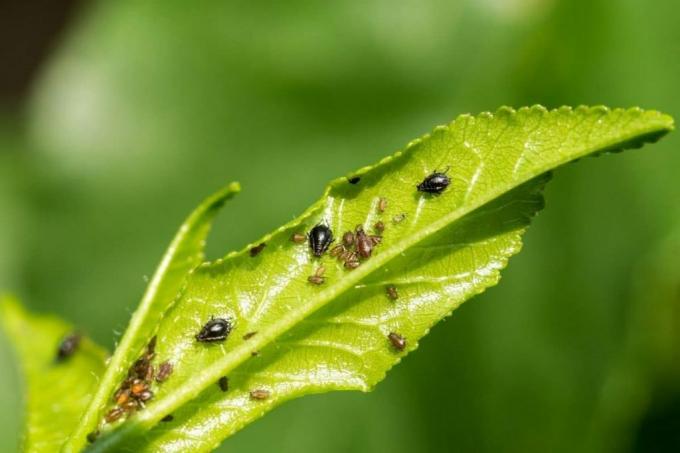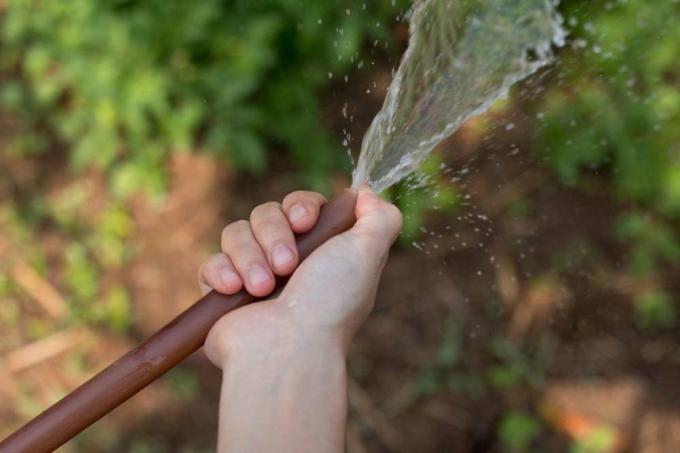
table of contents
- Different causes
- Malefactor: scale insect
- Recognize scale insects
- Measures against lice
- Mechanical combat
- Soapy water
- Rapeseed oil
- frequently asked Questions
In this country too, lemon trees are welcome guests on the balcony and terrace. They spread a pleasant atmosphere. In winter, however, they need appropriate winter quarters. Sometimes you can get sticky leaves here.
In a nutshell
- sticky drops on the lemon tree often during the winter break
- mostly occurring on the underside of the leaf, shoots and branches
- Malefactors are shields - sometimes also mealybugs and mealybugs
- a massive infestation causes lasting damage to the plant
- Combat mechanically or with soapy water and oil
Different causes
In summer, the lemon tree feels very comfortable outdoors. However, it is not hardy in our latitudes and therefore needs frost-free winter quarters. Sometimes sticky leaves appear very quickly during hibernation. There is not just one cause for this, but various possibilities such as:

- too warm and dark location
- too dry air
- Nutrient deficiency or excess
- improper watering
- no air circulation
The lemon tree usually “sticks” during the winter period, but sticky leaves can also appear during the growing season if the wrong location is chosen.
Malefactor: scale insect
Usually sticky sheets are mainly made of Scale insects caused. These suck the sap and then excrete sugar-containing droppings, the so-called honeydew. Since this contains a high proportion of sugar, the leaves are sticky. Not only are these glued, the immediate surroundings are also glued. Scale insects are able to hurl their excretions up to six inches. So it can happen that the floor sticks.
Recognize scale insects
Scale insects are relatively small, but can still be seen with the naked eye. As a rule, they are located along the ducts on the underside of the leaves, but also on smaller shoots and branches. Here the bark is still relatively soft and the sap can easily be sucked out. Special features are:
- have oval to round brown-black shields
- Size approximately 2 x 3 mm
- under shield laying of eggs by females
- Females often unable to move
- The white larvae hatch from July
- Larvae are motile
- like to attack leaves and shoots of neighboring plants
- only females suckle sap
- thereby giving off poisonous saliva
- Plant tissue is destroyed
- male specimens harmless
- have no mouthparts
- are often winged

A few brief remarks on mealybugs and mealybugs. They also damage the lemon tree by sucking out the sap. They are mainly found in the leaf axils and forks of the twigs and branches, sometimes also on the underside of the leaf. They are 3 to 4 millimeters in size and white to pink in color. Furthermore, the red spider mite can damage plants that are cultivated in the room or that are too warm and dark to overwinter. They are just under 0.5 to 1.0 millimeters in size and sit along the ducts on the underside of the leaf, where they also suck out the sap. Fine, white webs in the leaf axils, on the undersides of the leaves and shoot tips are typical. Control is the same as with lice.
Tip: If the ground sticks in the immediate vicinity of the lemon tree and ants are increasingly appearing, these are the first signs of an infestation with scale insects, especially outdoors. They love the lice droppings and take care of them and protect them.
Measures against lice
When combating lice, especially scale insects, chemical agents should be avoided if possible. These can sometimes damage the lemon tree itself and are also dangerous for the environment. There are various measures to drive scale insects away from the lemon tree.
Mechanical combat
This is arguably the easiest way to combat the cause. All you need is a hose with a nozzle and a toothbrush. The procedure is as follows:
- Lay the plant on its side
- Lice must not get into potting soil
- alternatively, cover the pot and soil with a plastic bag
- Rinse the plant with a sharp jet of water
- either using a nozzle or
- Squeeze the hose together at the end
- then use the toothbrush
- use it to carefully scrub off all the leaves and twigs
- Always move the brush at a right angle to the branch to be treated
- then shower the lemon tree again
- constant control in the following days
- repeat the procedure if necessary

Note: Smaller lemon trees can simply be immersed overhead in a bucket filled with lukewarm water for a few hours.
Soapy water
The use of soapy water can also help fight lice and sticky leaves. For this you need:
- 1 teaspoon of liquid or grated curd soap
- 1 liter of lukewarm water
- a spray bottle
Everything has to be mixed well. It is important that the soap has dissolved properly. The treatment can then take place:
- It is best to lay the plant down
- then spray well with the lye
- should act for a few hours
- preferably overnight
- shower thoroughly with clear water the following day
- Repeat the procedure after a few days
- thereby destruction of all eggs and hatched larvae
However, the use of soapy water can be a bit questionable if already existing fruits are intended for consumption.

Tip: A cotton ball soaked in alcohol can help with animals that appear individually. The lice are simply coated with it.
Rapeseed oil
Rapeseed oil can also be a good help in warding off lice. As with the use of soapy water, the airways are blocked and the animals suffocate. In addition, the leaves become slippery and the lice no longer have a hold. Before treatment, however, a large pile of paper should be laid out in order to avoid soil contamination. Then it can go:
- Prepare a mixture of 30% rapeseed oil and 70% water
- Spray the plant
- leave on for at least 3 hours
- then shower off with clear water
- repeat treatment if necessary
Note: Any remaining oily residues are disadvantageous during the treatment. However, this gives the leaves a nice sheen.
frequently asked Questions
Prevention is always better than cure. The location must be bright, sunny and sheltered from the wind. A humus-rich, slightly acidic, permeable soil such as special citrus soil is good. Care also plays a major role. Watering is seldom, but thoroughly, every day on hot days. The top layer of soil must be dry, lime-free water is used. Fertilization is necessary every 14 days in spring and weekly from June to September. Frequent spraying of the plant is also helpful.
Proper winter storage can prevent infestation. Temperatures between 3 and 13 ° C and not too bright are ideal. The colder the lemon tree is, the darker it has to be. The root ball should never dry out completely. At temperatures above 15 ° C, spraying with lukewarm water is helpful.
In the case of a very strong infestation and if all other means no longer help, systemically acting means may be used under certain circumstances. These are absorbed by the roots and distributed throughout the plant by the sap.
